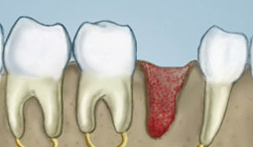Dental implants are the best replacement options we have available today, but not all patients are good candidates for dental implants. Sometimes, a bone graft is needed before the patient is able to get a dental implant surgery. But what is a bone graft?
The reason a patient will need a bone graft is because there needs to be a sufficient amount of bone to hold an implant in place. Imagine you’re building a fence and you put a fence post in the ground. The post needs to be deep enough for the dirt to hold the post in place.
That’s like why you may need a bone graft, to add enough bone to hold the implant in place.
If a tooth is getting extracted, a specific type of bone graft called a socket preservation graft will be needed to replace the empty space where the tooth once was. Once you take a tooth out you’re left with a hole that needs to be filled in. A socket preservation graft will fill that hole.
Socket preservation is one type of bone graft for a dental implant. If you need a dental implant to replace an upper tooth, there may not be enough bone because the sinuses, the spaces above your upper jaw, are too large, leaving too small an area of bone to put an implant in. In that case a different type of bone graft will be necessary.
The bone graft to add more bone to the upper jaw is called a sinus lift bone graft. The procedure “lifts” the bottom of the sinus so there is sufficient room and bone for a dental implant. After the sinus is lifted, bone graft material is packed into the space. Once healing has occurred, the patient is ready for a dental implant to be placed in the area.
As you can see, a dental implant would not have enough bone to be stabilized without the grafted bone in the sinus lift.
If you need a dental implant in the lower jaw, a sinus lift bone graft is not possible. We don’t have sinuses in our lower jaws! So, another type of bone graft is needed to add bone to the lower jaw to stabilize dental implants.
If socket preservation grafts and small amounts of particulate bone grafts are not enough to add enough bone to the lower jaw, a larger bone graft will be needed. Large pieces of bone, not small particles, added, or grafted, to the lower jaw are called block grafts. Block grafts are larger blocks of bone that are physically attached to the jaw bone. After healing, the block graft becomes integrated to the patient’s own jaw bone. Usually, block grafts for dental implants are required when there is a large amount of bone missing and several teeth have been missing for a long time.










Leave A Comment
You must be logged in to post a comment.